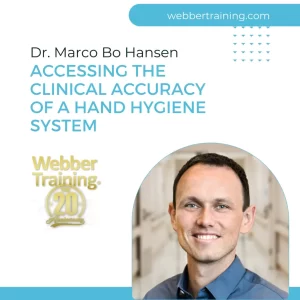This blog post will help you achieve the best Leapfrog Hand Hygiene Safety Grade with fewer resources, easier reporting, and higher data quality.
What is Leapfrog?
The Leapfrog Hospital Safety Grade is an objective evaluation process that can help healthcare organizations measure, assess, and improve performance to provide safe, high-quality patient care.
The Leapfrog Safety Grade is important for your hospital’s reputation and functioning as health plans and self-insured corporations incorporate Leapfrog’s data into their member education, provider selection, and value-based purchasing programs. Leapfrog also collaborates with the Joint Commission around accreditation, which can impact reimbursement and financial incentives.
Finally, the Hospital Safety Grade creates transparency and offers important guidance, which helps patients and family members make informed decisions on protecting themselves during a hospital stay.
LeapFrog emphasizes the importance of hand hygiene. However, achieving an “A” grade on this survey displays more than a generic commitment to hand hygiene.
To secure that top grade, consider these three insights:
1. Time-saving initiatives
The Leapfrog Survey asks hospitals to collect 200 hand hygiene opportunities monthly per unit. This is a time-consuming task with little personal reward, and hospitals need help balancing these requirements to not impact patient care. Time and workforce are costly factors in hospital budgets in a time with inadequate staff resources. The need to collect and collate so much data is one reason Leapfrog is encouraging electronic hand hygiene systems.
Sani Nudge automates the data collection and analyses, making the Leapfrog reporting an efficient and easy process. Sani Nudge collects >5000 hand hygiene opportunities per unit monthly. The Leapfrog’s Factsheet stresses the value: “Facilities that have adopted electronic compliance monitoring systems are better able to determine their actual hand hygiene compliance rate, creating the opportunity for more robust quality improvement initiatives.”
2. Inaccurate data might be a problem in your organization
The number of hand hygiene opportunities (quantity) is important to ensure robustness in the analyses, but so is the accuracy (quality) of the data. Direct observations are manual processes impacted by the Hawthorne effect, on average overestimating hand hygiene compliance by a factor 2-3. It means you do not have a true picture of your hospital’s actual hand hygiene compliance behavior. Inaccurate data can put patients at risk of harm.
Leapfrog states: A hospital that chooses to use direct observation to assess hand hygiene compliance will need to conduct regular quality monitoring of the accuracy of observations that are collected by each observer. This monitoring would include having an individual trained in infection control simultaneously collecting data with the hand hygiene compliance observers and comparing results. Hospitals that utilize direct observation must regularly devote at least 2-10 staff members to hand hygiene observation, depending on hospital size.
Sani Nudge uses sensor technology to collect data objectively. It means that the observer bias (Hawthorne effect) is eliminated, providing hospitals with the true compliance numbers for your reports. Sani Nudge is the most published and validated electronic hand hygiene system on the market. Read about the peer-reviewed validation studies here.
3. Validation made easy
Leapfrog wants accurate hand hygiene data because inaccurate data won’t help healthcare organizations make meaningful patient safety improvements. Excellent hand hygiene compliance is only useful if it is correct. Leapfrog requires hospitals’ electronic hand hygiene systems to be validated by hospital personnel or third-party personnel.
Sani Nudge differs from other solutions with peer-reviewed validation articles published that healthcare organizations can use and refer to. At the same time, Sani Nudge offers a structured validation protocol for hospitals to follow if they want to conduct their own validation. In addition, Sani Nudge has built-in nudge features that allow the assessors to quickly see if a hand event or hand hygiene opportunity has been registered correctly.
Don’t hesitate to contact us if you want help to make your Leapfrog reporting easy while earning a top Safety Grade.
|
What is The LeapFrog Safety Grade? ✓ |
|
Which hospitals are excluded from The LeapFrog Safety Grade? 🏥
|




